September 27, 2021 — A long lost piece of the moon belonging to the state of Louisiana may have remained missing — if not also been discarded or destroyed — had the plaque on which it was mounted not attracted the eye of a Florida gun collector.
The man, who was looking for wood samples to use in the repair or replacement of his damaged gunstocks, purchased the Apollo 17 goodwill moon rock display without realizing what it was. The buyer, who requested to remain anonymous but resides in Merritt Island, near Cape Canaveral, said that he had likely purchased the plaque at a garage sale sometime over the past 15 years.
"I can't even tell you how long I owned it for," the man told collectSPACE after reaching out for information through a common contact. "I'm not even sure how much I paid for it. I buy plaques because I take the wood from the plaques and I send it over to my gunstock guy and he makes grips for my Colts and so forth."
"The wood [in the plaques] is such nice wood that is what I buy them for," he said.
It was not until the past two years, when he was seeking a particular color wood for a repair, that he pulled the moon rock-adorned plaque from one of the 15 to 16 boxes of plaques that he had amassed for his hobby.
"What the hell is this?" he recalled thinking after taking a good look at what was on the plaque for the first time. "Before I start stripping things off, I generally take a moment to read them."
'Mankind's hope'
The 10-inch-wide by 14-inch-tall (25 by 35 cm) plaque had mounted to its top a small lucite ball embedded with a 1.142 gram (0.04 oz) sample of lunar rock, part of a larger piece of the moon collected by Apollo 17 astronauts Eugene Cernan and Harrison Schmitt in 1972. The moonwalkers dedicated the rock as a symbol of goodwill while standing on the lunar surface.
"This fragment is a portion of a rock from Taurus Littrow Valley of the Moon. It was part of a larger rock composed of many particles of different shapes and sizes, a symbol of the unity of human endeavor and mankind's hope for a future of peace and harmony," a metal plate affixed below the lucite-encased moon rock reads.
Also on the plaque is a 4-by-6-inch (10-by-15 cm) flag of the state of Louisiana.
"This flag of your state was carried to the Moon aboard Spacecraft America during the Apollo XVII mission, December 7-19, 1972," a second metal plate reads. "Presented to the people of the state of Louisiana by the National Aeronautics and Space Administration."
At the direction of then-President Richard Nixon, NASA prepared almost 200 such plaques to be presented to the 50 U.S. states, the country's provinces and 136 foreign nations (the wording on the international-gifted plaques differed slightly, noting that they were a gift from the people of the U.S. to the public of the recipient country).
"I started reading it and thought, 'Hmm, that's a little strange.'" said the man who had bought the plaque at a garage sale. "So I went to the internet and found out, 'Oh! They are looking for this puppy.'"
Missing moon rocks
The Apollo 17 goodwill moon rock presentations were the second and last time that the United States gifted astronaut-recovered lunar material. The vast majority of the 842 pounds (382 kg) of moon rocks and soil brought back by the six U.S. moon landing missions remain in NASA vaults, with samples periodically loaned to researchers, educational institutions and museums.
Once gifted, the Apollo 17 goodwill moon rocks (and earlier, similarly-gifted Apollo 11 lunar sample displays) were no longer NASA or the U.S. federal government's responsibility to track. For the first 30 years after their presentation, no one was keeping a record of where they were displayed, held in storage or otherwise went.
After one sample gifted to a foreign nation ended up at the center of a U.S. court case to determine its rightful ownership, a volunteer-led search (spearheaded by collectSPACE) began in 2002 to locate them all. To date, of the 379 known displays, the location of 171 are unknown (including three known to be stolen and one that was lost to a garbage dump after a building fire).
Of the moon rocks gifted to U.S. states alone, New York and Delaware are missing their Apollo 11 displays (Delaware's being among the three documented as stolen) and Michigan, New Jersey, Ohio and South Carolina have been unable to locate their pieces of the Apollo 17 goodwill moon rock.
Louisiana was missing both of its moon rock gifts until 2018, when a journalist with a local newspaper tracked down the Apollo 11 display to the Louisiana Art and Science Museum in Baton Rouge. Chief curator Elizabeth Weinstein confirmed the lunar sample had been there since 1982.
"As for the piece of the Apollo 17 moon rock that was given to Louisiana, Weinstein had no idea where it might be," Grace Toohey with The Advocate wrote in August 2018. "There is no record of its presentation or exhibit in The Advocate's archives. The Louisiana State Museum and state archives and governor's office had no record of it, though the governor's office said it is still looking."
Hand delivered
After realizing what he had, the Florida man who had bought the goodwill moon rock reached out to the Louisiana's governor office. From there, he was directed to Louisiana State Museum.
"They wanted me to mail it out to them," the man recalled. "I said, 'I'm not mailing this thing out to you. I will hand deliver it,' and with that said, that is what I did."
"He did indeed hand over the moon rock to the museum," Steven Maklansky, interim director of the Louisiana State Museum, told collectSPACE in an interview. "We did take possession of the rock."
Though now restored to the state to which it was originally gifted, it is still unknown how the moon rock made its way to another state, let alone turn up in a private sale. Maklansky said the museum has no plans for a further investigation, instead choosing to focus on the outcome.
"I think it is an extraordinary piece of Louisiana history. Obviously then, Louisiana State Museum would be a fitting venue for it to be held for posterity and also offered for public display," he said. "We're excited to take possession of this piece and to share it with our audiences."
Discussions about how and when the moon rock might go on public display were just getting started when Hurricane Ida hit Louisiana in late August. After several weeks closed to recover fro the storm, the state museum has now reopened and those discussions may resume soon.
"I think this is indeed the first piece of Louisiana history that comes from someplace other than planet Earth," said Maklansky. "We're excited that our collection has broadened its scope in this fashion. The reach of New Orleans and Louisiana has spanned across all continents and we like to make connections about the relevancy of our art, history and culture to other places. So, it is great that we can make a connection now between Louisiana and the moon." |
|
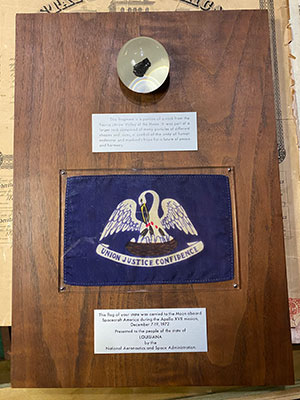
Louisiana's Apollo 17 goodwill moon rock display was returned to the state after being purchased by a gun collector at a Florida garage sale for its wooden plaque. (Source file / collectSPACE)
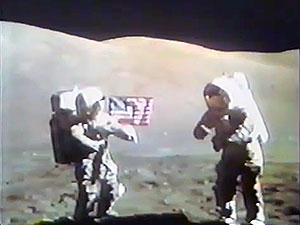
Apollo 17 astronauts Gene Cernan (at right) and Harrison Schmitt dedicate the goodwill moon rock in December 1972. (NASA)
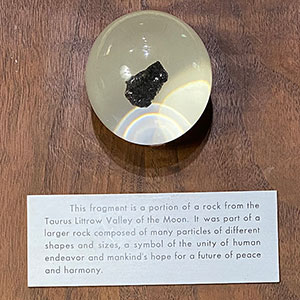
Each Apollo 17 goodwill display includes a 1.142 gram sample from a parent 2,957 gram stone. (Source file/collectSPACE)
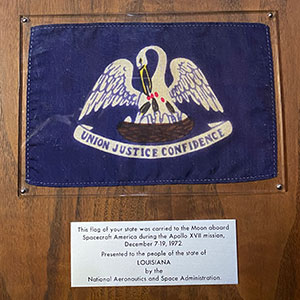
In addition to a piece of the moon, the Apollo 17 goodwill displays include a flag of the recipient state or nation that was flown to the moon on the last lunar landing mission. (Source file/collectSPACE)
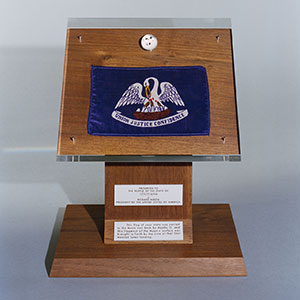
Louisiana's Apollo 11 lunar sample display is held by the state's Art and Science Museum in Baton Rouge. (NASA via collectSPACE) |
